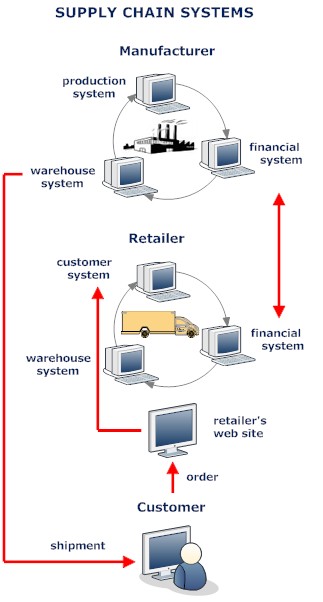 Section
Navigation
Section
Navigation
5. Gaining an Online Presence
Business to Customer
:Without a website
5.1 eMail Marketing
5.2 Merchant Services
5.3 Creating Mobile Applications
5.4 Newsletters
5.5 Selling on eBay
:Using Third Party Platforms
5.6 Marketing Platforms
5.7 Free Services
5.8 Social Media
:With a Website
5.9 Building a Website: Introduction
5.10 Building a Website: Technical
5.11 Mobile Web Pages
5.12 Professional Pages
5.13 Shopping Carts
5.14 Payment Systems
5.15 Site Hosting
5.16 Webzines
5.17 Auctions
5.18 Blogs
5.19 Content Management Systems
5.20 Web Portals
5.21 Wikis
:With a Website:
Types
5.22 Selling Content
5.23 ePublishing
5.24 Distance Learning
5.25 Selling Advertising
5.26 Becoming an AdSense Publisher
5.27 Becoming an Affiliate
5.28 Selling Physical Goods
5.29 Corporate eCommerce
5.30 eCommerce Servers
5.31 Staying Safe
:Business to Business
5.32 Customer Relationship Management
5.33 Supply Chain Management
5.34 Digital Exchanges
5.35 eProcurement
5.36 Industrial Consortia
5.37 Private Industrial Networks
 5.33
Supply Chain Management
5.33
Supply Chain Management
Supply chain management (SCM) is the management of a network of interconnected businesses involved in the ultimate provision of product and service packages required by end customers. {1}
Other definitions explain further. 'Supply chain strategies require a total systems view of the linkages in the chain that work together efficiently to create customer satisfaction at the end point of delivery to the consumer. As a consequence costs must be lowered throughout the chain by driving out unnecessary costs and focusing attention on adding value. Throughput efficiency must be increased, bottlenecks removed and performance measurement must focus on total systems efficiency and equitable reward distribution to those in the supply chain adding value. The supply chain system must be responsive to customer requirements.' {2}
'Supply chain management is the systemic, strategic coordination of the traditional business functions and the tactics across these business functions within a particular company and across businesses within the supply chain, for the purposes of improving the long-term performance of the individual companies and the supply chain as a whole.' {3}
Supply chain management software (SCMS) is a business term which refers to an integrated range of software tools or modules used in executing supply chain transactions, managing supplier relationships and controlling associated business processes. Such systems, which commonly allow forecasting and include report and chart creation tools, cover five areas:
1. Customer requirement processing.
2. Purchase order processing.
3. Inventory management.
4. Goods receipt and warehouse management.
5. Procurement.

Classification
Supply chain management embraces Industrial Consortia, Digital Exchanges and Private Industrial Networks. eProcurement lacks the two-way interconnected flow of information.
Unsegregated |
Supply Chain Management |
|
||
Vertical or HorizontalMarket |
Vertical |
Horizontal |
||
Owned By |
Several Companies |
3rd Party IndependentOperator |
One ControllingCompany |
3rd PartyIndependent Operator |
Size |
Varies |
Small |
Large |
Small |
Grouping |
Industrial Consortium |
Digital Exchange |
Private IndustrialNetwork |
eProcurement |
Evolution
SCM had its origin in factory assembly lines and Japanese management practice, took practical shape in the Electronic Data Interchange (EDI) systems of the 1960s, and was developed through the 1990s into Enterprise Resource Planning (ERP) systems. These were firstly unlinked systems independently controlling Production, Storage, Distribution, Material Control, etc. In a second stage of development, these systems were integrated under one plan, and this last plan was then vertically integrated with upstream suppliers and downstream customers.
This model was developed further, first by being expanded over national boundaries (globalized), then specialized as companies focused on 'core competencies' and built networks of 'best-in-class partners' that were themselves responsive to market changes in suppliers and customers. Finally, (Web 2.0) companies diversified , using the Internet to increase creativity, information sharing, and collaboration among partners and others.
Problems
Earlier implementations were unrealistic, not sufficiently aware that manufacturers have customer preferences, delivery times can be negotiable, and that supply interruptions are sometimes beyond the control of all parties. Improvements have come with better exchange of information, more diverse supply lines and disaster planning.
Advantages
A realistic and properly implemented SCM system offers many benefits:
1. Better management of all the factors contributing to the purchase
and production cycles.
2. Reductions in human error.
3. Greater productivity.
4. Lower costs
5. Reduced inventories.
6. Shorter planning times.
7. Better communication between departments.
8. More reliable forecasting.
 Questions
Questions
1. Explain how supply chain management systems work.
2. Outline supply chain management systems' eight areas of application.
3. How did supply chain management systems evolve: give a short history
of the US development.
4. What the advantages and disadvantages of supply chain management
systems?
 Sources and Further Reading
Sources and Further Reading
1. Harland, C.M. (1996) Supply Chain Management,
Purchasing and Supply Management, Logistics, Vertical Integration, Materials
Management and Supply Chain Dynamics, in Slack, N (ed.) Blackwell
Encyclopedic Dictionary of Operations Management. Blackwell. 1996.
2. Hines, T. (2004) Supply chain strategies: Customer driven and
customer focused. Oxford: Elsevier.
3. Mentzer, J.T. et. al. (2001) Defining Supply Chain Management,
in Journal of Business Logistics, Vol. 22, No. 2, 2001, pp. 1-25
4. Supply chain management. Wikipedia.
Detailed entry with history, a little theory and extensive references.
5. A comparison of coordinated supply chain inventory management
systems by D.L. Olson and M. Xie in International Journal of
Services and Operations Management. Vol. 6, No.1 pp. 73 - 88 . 2010.
6. Supply Chain Management Systems. 2010. Epiq.
Short account of problems with earlier systems.
7. Supply chain leaders identified by Paul Taylor. FT.
July 2011. Current state of play.